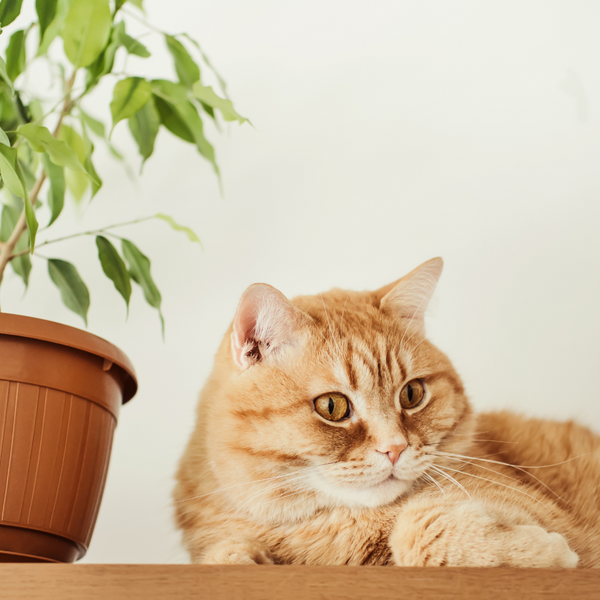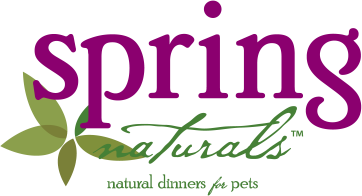
Pets vs. Houseplants - What To Do About Your Curious Pet
(Dr. Iulia Miha, DVM) Imagine your indoor space filled with beautiful blooming plants but you notice your pet happily munching away on one of them. As nice as this scenario may seem, it can put your beloved pet's life in danger.
We all know that pets are extraordinarily curious, some even more so when it comes to plants. They can nibble or ingest the plants out of curiosity, boredom, or simply because they like the taste or texture. However, not all houseplants are safe for pets. As a plant and pet owner, it is wise to document what plants you have and research their potential toxicity. Read this article to learn what plants are toxic to pets and what you can do about your curious furball.
What To Do About Your Curious Pet
Pets and houseplants can have a difficult to impossible relationship. Unfortunately, you can't really keep houseplants where you have pets unless they are safe for ingestion or in places where your beloved four-legged friend cannot reach them. Both dogs and cats love to explore everything new and plants certainly are fair game. They will dig at the soil in the pots (some cats will even do their business there) and nibble the flowers and leaves of the plants. Here's what you can do to mitigate some of these issues:
- Document and research the toxicity of your plants, specfically whether or not it is toxic to pets.
- Start vertical gardening to keep plants out of reach.
- Place your plants in places or rooms where pets cannot reach.
- Create barriers around your plants such as chicken wire or terrariums.
- Distract your pet. Whenever your pet gets curious about your plants, distract them with a toy.
- Cover the soil. If your pet likes to dig in your pots, you can use pebbles or rocks to cover the dirt so your pet won’t be able to reach it.
- Use orange or lemon peels. If you have a cat, place citrus peels over the soil as cats don’t like the smell of citrus fruit.
- Get plants that your cat will enjoy munching on, such as catnip or barley.
15 Toxic Houseplants for Pets
- Aloe Vera – This plant has many benefits for us but is toxic to cats. Once ingested, it can lead to digestive problems such as vomiting, diarrhea, and dehydration.
- Lilly – These flowers have an exquisite fragrance but are toxic to pets. In fact, lilies are on the list of the most toxic plants. All parts of the plant are toxic, including the pollen or the water in the vase. In cats, once ingested, lilies can lead to kidney failure in a few days, convulsions, and arrhythmias. Dogs are not as sensitive as cats but can develop gastrointestinal problems if they ingest parts of the plant.
- Begonia – These plants are toxic to both dogs and cats. However, you must remember that if you have small children, it is toxic for them as well. Although the tubers of the plant are the most harmful, ingesting any part of the plant can lead to hypersalivation, vomiting, difficulty swallowing, and an intense burning sensation in the lips, oral cavity, and throat.
- English Ivy – This plant is toxic both for dogs and cats. The leaves are the most toxic and, once ingested, can cause gastrointestinal issues such as vomiting, diarrhea, abdominal pain, and hypersalivation.
- Ficus – Ficus leaves are the most dangerous for pets. Once ingested, they can lead to skin inflammation, irritation in the oral cavity, hypersalivation, and vomiting.
- Azalea – All parts of the plant are toxic to pets. In dogs, ingesting 0.2% of their body weight can lead to poisoning, irritation and vomiting.
- Poinsettia – If your pet consumes this plant, clinical signs such as vomiting or irritation of the oral cavity and stomach may occur.
- Philodendron – This plant has a fairly low level of toxicity (mild to moderate). Once ingested, it can lead to clinical signs such as excessive salivation, difficulty swallowing, swelling of the oral cavity and tongue, and oral irritation and pain.
- Dracaena – This plant is toxic to both dogs and cats. Once ingested it can lead to clinical signs such as anorexia, depression, vomiting (sometimes with blood), nervous signs, dilated pupils, and hypersalivation.
- Dieffenbachia – Also called dumb cane, this plant is also poisonous to humans. Once ingested by your pet, this plant can lead to vomiting, abundant salivation, difficulty in swallowing, intense burning sensation in the mouth, and swelling of the mouth and tongue.
- Jade – Once ingested, this plant can lead to mild digestive problems, stumbling gait (incoordination), depression, and lethargy. In most cases, the clinical signs resolve on their own.
- Cyclamen - Ingested in small quantities can lead to digestive problems, vomiting, diarrhea, and excessive salivation. If your pet has ingested larger amounts, you can expect to see irregular heart rhythms and seizures. In severe cases, ingestion of cyclamen can lead to the death of your pet.
- Snake Plant – The toxicity of this plant is mild to moderate. Once ingested, it can lead to digestive symptoms such as excessive salivation, vomiting, and diarrhea, but also to dilated pupils.
- Peace Lily – This plant is mildly toxic to dogs and cats. If ingested it can lead to gastrointestinal issues (vomiting, diarrhea, hypersalivation), rash and skin inflammation, burning sensation in the oral cavity, and difficulty breathing (in rare cases).
- Chrysanthemum – This plant is toxic to both cats and dogs. The clinical signs can include vomiting, excessive salivation, incoordination, diarrhea, and dermatitis.
What to Do When Your Pet Has Ingested Toxic Houseplants
If your pet has ingested a toxic houseplant, the first step is to contact your veterinarian because they can tell you the next safe steps you can take to help your beloved four-legged friend. If you cannot contact your veterinarian, it is advisable to give your pet activated charcoal orally. This medicine will help absorb toxins from your dog or cat's body.
Inducing vomiting is not recommended unless indicated by the veterinarian. This procedure is quite simple for dogs, but for cats it can have adverse effects. Therefore, it is recommended not to try something like this at home. Inducing vomiting with salt water can lead to salt poisoning if you use too much salt. In the case of hydrogen peroxide, inducing vomiting in dogs is relatively safe, but in cats, it can lead to serious health problems and is not considered safe. Inducing vomiting with hydrogen peroxide in cats can lead to the following health problems:
- Stomach inflammation
- Gastric ulcer
- Esophageal ulcer
- Damage of the epithelial tissue, which can lead to intestinal bleeding
It is also important to know what type of plant your pet has consumed so that the veterinarian can administer the most appropriate treatment.
Unfortunately, the cases of poisoning in dogs and especially cats with houseplants are quite frequent. For this reason, it is best to keep these plants away from the prying eyes of your pet.
Conclusion
There are a multitude of houseplant species that delight our eyes but can be deadly for our beloved pets. Pets are known to nibble on our houseplants out of sheer boredom, because they like the taste or texture, or because it's simply something new and they are curious about. For these reasons, it is advisable to always do some research when you want to buy and bring home a new plant. This small consideration can save your pet's life.
If you already have plants at home or you received one or more as a gift, it is recommended to keep them away from the prying eyes of your dog or cat, to place them in high places or in a room where your four-legged friends do not have access. Most houseplants, if ingested, lead to minor or major digestive problems (vomiting, diarrhea) depending on how much your pet ingested. However, there are some plants that can lead to skin irritation, mouth irritation, nervous signs, kidney failure, and even death. If you have noticed that your pet has ingested a toxic plant, contact the veterinarian immediately.
Dr. Iuliana Mihai, DVM, Masters In Small Animals And Equines Pathology
Iuliana graduated from the University of Agronomical Sciences and Veterinary Medicine in 2012, Romania. She has a Master’s degree in Small Animal and Equines Pathology and a strong affinity for Veterinary Parasitology and Laboratory. In 2013 she started her Ph.D. in epithelial cancer in dogs and cats. She volunteered at the faculty’s clinic in her 3rd year of study, and continued her career in small animal pathology and laboratory. She has one cat and eleven rats. Her interests outside of work include traveling, writing, and crafting.

Post a Comment!